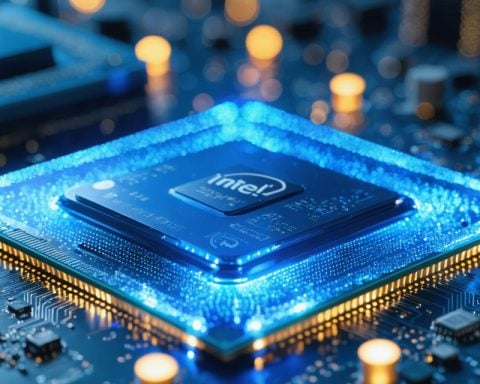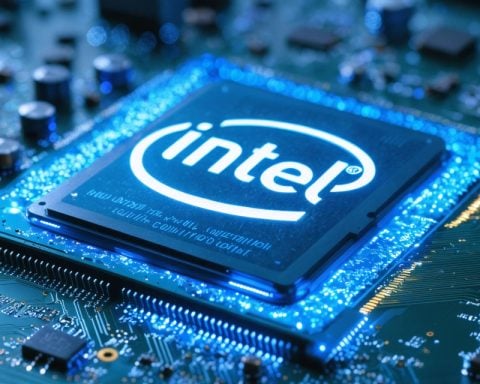- Nvidia remains crucial in AI advancements despite concerns over training efficiency breakthroughs like DeepSeek’s.
- Massive capital expenditures from tech giants such as Meta, Alphabet, and Amazon indicate strong ongoing demand for Nvidia’s technology.
- Meta is expected to invest up to $65 billion, while Alphabet and Amazon plan to spend $75 billion and $100 billion, respectively, on AI infrastructure.
- Nvidia’s high-performance GPUs are essential for executing complex AI calculations, maintaining its market leadership.
- The company continues to deliver impressive revenue figures despite recent stock price dips, hinting at potential for future growth.
- Investors may see current conditions as an opportune moment to engage with Nvidia’s promising financial outlook.
The tech giant Nvidia, a powerhouse in the world of artificial intelligence, currently unveils a tantalizing scenario for investors. Despite seismic shifts and innovations in AI training efficiency, Nvidia’s chips remain vital for powering AI’s expansive frontiers. DeepSeek’s breakthrough, which showed AI models could be trained more economically, initially shook the confidence in Nvidia’s once seemingly invincible growth trajectory. But look closer.
As the clouds part, a vibrant horizon reveals itself. Reports of slumps are overshadowed by skyrocketing capital expenditure projections from tech behemoths like Meta, Alphabet, and Amazon, signaling unstoppable demand. These companies stand ready to pour unprecedented sums into AI infrastructure, reinforcing Nvidia’s indispensable role. Meta’s planned expenditure ranges between $60 billion and $65 billion. Alphabet and Amazon soar even higher, preparing to invest $75 billion and a staggering $100 billion, respectively. This capital injection spells out a bright narrative for Nvidia’s financial future.
Yet, it’s not just the colossal spending that makes Nvidia attractive. The company’s high-performance graphics processing units (GPUs) remain the brains behind much of today’s AI advances, able to execute complex calculations with unparalleled efficacy. Nvidia’s consistent delivery of stellar revenue figures showcases its firm entrenchment in the market.
Now, with the company’s stocks trading well below previous peaks due to warranted but exaggerated fears, history nudges the tentatively optimistic to consider this moment. Investors who once embraced similar opportunities have often reaped significant returns. Thus, the stage is set for Nvidia to continue its ascent.
So, while the broader market may perceive shadows of doubt, discerning investors see a period rich with potential. This could well be the moment when Nvidia’s story becomes an integral chapter in your investment portfolio.
Why Nvidia Remains the Crown Jewel in AI Investments: Unlocking Future Potential
How-To Steps & Life Hacks for Investing in Nvidia
1. Research Market Trends: Understand where Nvidia stands in the broader context of the AI and GPU markets. You can access resources such as industry reports and financial news outlets for updated information.
2. Analyze Financial Statements: Look at Nvidia’s revenue growth, profit margins, and expenditure reports to assess the company’s financial health.
3. Diversify Portfolio: While Nvidia is promising, always diversify your tech investments to hedge against potential market volatility.
4. Watch for Key Partnerships and Acquisitions: Nvidia often engages in strategic partnerships and acquisitions that can signal growth in new sectors.
5. Set Investment Goals: Decide whether you are looking for short-term gains or long-term profitability before purchasing Nvidia stocks.
Real-World Use Cases of Nvidia Technology
– Autonomous Vehicles: Nvidia’s GPUs are crucial in developing real-time processing systems for self-driving cars.
– Healthcare: Its technology powers diagnostic imaging and personalized medicine, allowing for quicker, more accurate patient analyses.
– Financial Services: Banks use Nvidia’s AI solutions for predictive analytics and fraud detection.
– Entertainment: From gaming to movie production, Nvidia’s graphics capabilities are leveraged to create realistic simulations and high-fidelity digital content.
Market Forecasts & Industry Trends
– Growth in AI Applications: According to a report from Allied Market Research, the AI market, bolstered by GPU advancements, is expected to grow at a CAGR of nearly 43% from 2020 to 2027.
– Rise in Cloud Computing Investments: As more companies transition to cloud-based solutions, Nvidia’s GPUs are becoming essential, influencing broader adoption over the next decade.
Reviews & Comparisons
– Nvidia vs. AMD: Nvidia generally leads in performance metrics for AI applications, while AMD is a strong competitor in cost-effectiveness, making them a viable option for more budget-conscious users.
– Nvidia vs. Intel: Intel is integrating GPUs into its processors to capture some of Nvidia’s market share, but lacks the specialized capabilities Nvidia has established in the AI space.
Controversies & Limitations
– Environmental Impact: Nvidia, like many tech companies, faces scrutiny over the environmental footprint of its manufacturing processes. Steps are being taken to use more sustainable materials and practices.
– Market Volatility: Tech stocks, including Nvidia, can be highly volatile due to rapid changes in innovation and global economic shifts.
Features, Specs & Pricing
– Flagship GPU: The Nvidia RTX 4090 is among the highest-performing GPUs, featuring state-of-the-art ray tracing technology and deep learning super sampling (DLSS).
– Pricing: High-end GPUs can range from $500 to over $1,500, with enterprise solutions costing significantly more.
Security & Sustainability
– Data Security: Nvidia is investing in AI for cybersecurity solutions, enhancing its offerings beyond just hardware.
– Sustainable Manufacturing: The company is committed to reducing carbon emissions and improving energy efficiency across its operations.
Insights & Predictions
– Continued Innovation: Nvidia is expected to maintain its market leadership through continuous R&D, particularly in AI processing and quantum computing solutions.
– Increased Demand: As AI integration grows across sectors, Nvidia’s products will likely see increased demand.
Tutorials & Compatibility
– Developer Resources: Nvidia provides comprehensive tutorials and developer kits to facilitate integration across various applications, from game development to AI research.
– Cross-Platform Compatibility: Its GPUs are designed to work seamlessly with a wide range of platforms, providing flexibility for developers.
Pros & Cons Overview
Pros:
– Industry-leading performance in AI and graphics
– Strong financial standing with consistent growth
– Broad applicability across diverse industries
Cons:
– High initial investment for cutting-edge technology
– Volatility risk due to rapid technological change
Actionable Recommendations
– Stay Informed: Regularly monitor updates on Nvidia’s financial health and technological advancements.
– Invest Strategically: If you decide to invest, consider using a dollar-cost averaging approach to mitigate risks associated with market volatility.
For those interested in Nvidia and similar investments, check out the official link for Nvidia.
Leveraging Nvidia’s strengths may afford investors a remarkable opportunity to capitalize on AI’s unfolding evolution and other technological breakthroughs.



















